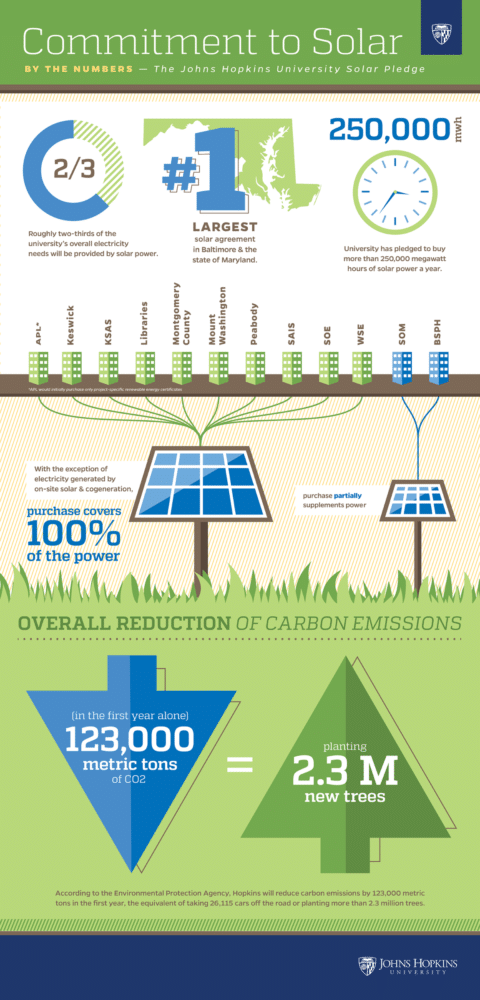Marking the largest commitment to solar purchasing by any corporation or institution in Maryland, Johns Hopkins University has announced a 15-year agreement with Exelon subsidiary Constellation to purchase power and renewable energy credits from a 175 MW solar project under development by Constellation in Virginia.
The power supplied by this plant will represent 2/3 of the annual electricity consumption among all Johns Hopkins main and satellite campuses, minus the the School of Medicine and the Bloomberg School of Public Health, which will be partially covered. The move also represents a step towards achieving the university’s 2008 Climate Action Plan, which outlines a goal of reducing carbon emissions by 51% from projected 2025 levels. And, while there is no presented date, the university has an ultimate goal of carbon neutrality. This commitment is quite the active start to carbon reduction efforts, as in the first year alone the power from this project will represent 123,000 metric tons of avoided carbon emissions.

“When we pledged to more than halve our carbon emissions by 2025, we knew it would require rethinking how we power and operate our university,” said Johns Hopkins University President Ronald J. Daniels upon the agreement’s unveiling. “This agreement demonstrates the seriousness of our commitment to sustainability for the good of our university and our planet.”
Like we’ve seen with state-level legislation, more and more colleges and universities are making the switch to renewables, particularly solar. Stanford University, the University of Richmond and Massachusetts’ Hampshire College are all entirely offsetting their electricity usage with solar. The University of Hawai’i and University of California systems have both got in the mix as well, making 100% renewable energy a near-future goal.
And, in what will hopefully add to this growing list, a bill has been introduced to the Minnesota state legislature which would grant up to $6 million for the University of Minnesota to transition to renewable energy through “solar efforts,” most likely development or purchase agreements. And, keeping up with university transitions matching legislation, the Minnesota house last night passed a bill that includes a mandate that utilities source all of their power from carbon-free energy sources by 2050.
While not happening quite as quickly as state renewable energy initiatives, this latest commitment shows a promising energy future coming from the education centers of the world’s future.
Note: The original version of this article stated that the University of North Carolina was receiving solar from a Duke Energy direct supply, which was not accurate.
This content is protected by copyright and may not be reused. If you want to cooperate with us and would like to reuse some of our content, please contact: editors@pv-magazine.com.









By submitting this form you agree to pv magazine using your data for the purposes of publishing your comment.
Your personal data will only be disclosed or otherwise transmitted to third parties for the purposes of spam filtering or if this is necessary for technical maintenance of the website. Any other transfer to third parties will not take place unless this is justified on the basis of applicable data protection regulations or if pv magazine is legally obliged to do so.
You may revoke this consent at any time with effect for the future, in which case your personal data will be deleted immediately. Otherwise, your data will be deleted if pv magazine has processed your request or the purpose of data storage is fulfilled.
Further information on data privacy can be found in our Data Protection Policy.